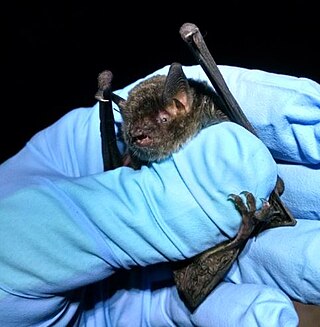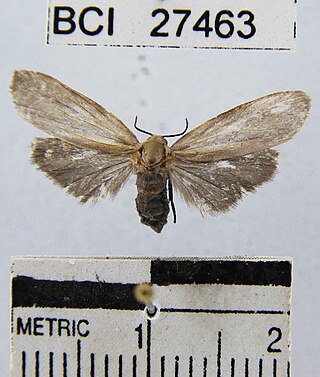
Emporia State University is a public university in Emporia, Kansas, United States. Established in March 1863 as the Kansas State Normal School, Emporia State is the third-oldest public university in the state of Kansas. Emporia State is one of six public universities governed by the Kansas Board of Regents.

The gray bat is a species of microbat endemic to North America. It once flourished in caves all over the southeastern United States, but due to human disturbance, gray bat populations declined severely during the early and mid portion of the 20th century. 95% of gray bats now hibernate in only 15 caves. M. grisescens has been listed as federally endangered by the U.S. Fish and Wildlife Service since 1976, and is protected under the Endangered Species Act. Gray bat populations were estimated at approximately 2 million bats around the time they were placed on the Endangered Species list. By the early 1980s populations of gray bats dropped to 1.6 million. With conservation efforts in place, in 2004, gray bat populations were estimated to have reached 3.4 million.
The Kansan glaciation or Kansan glacial was a glacial stage and part of an early conceptual climatic and chronological framework composed of four glacial and interglacial stages.
The Beestonian Stage is an early Pleistocene stage in the geological history of the British Isles. It is named after Beeston Cliffs near West Runton in Norfolk where deposits from this stage are preserved.
Apogurea is a monotypic moth genus in the subfamily Arctiinae erected by Watson, Fletcher and Nye in 1980. Its single species, Apogurea grisescens, was first described by Franz Daniel in 1951. It is found in Zhejiang, China.

Camptogramma is a genus of moths in the family Geometridae erected by James Francis Stephens in 1831. It is considered by some to be a synonym of Euphyia.
The Pre-Illinoian Stage is used by Quaternary geologists for the early and middle Pleistocene glacial and interglacial periods of geologic time in North America from ~2.5–0.2 Ma.

The Emporia State Hornets football program is a college football team that represents Emporia State University, often referred to as "Emporia State" or "ESU". The team competes as a member of the Mid-America Intercollegiate Athletics Association (MIAA), which is a conference in the Division II of the National Collegiate Athletic Association (NCAA). The program began in 1897 and has fifteen conference titles. On December 15, 2006, former Hornet quarterback Garin Higgins became the team's 24th head coach, following the resignation of Dave Wiemers. Home games are played on Jones Field at Welch Stadium, located on the Emporia State University campus in Emporia, Kansas. In August 2017, Hero Sports named Emporia State the "best football team in Kansas, regardless of division."
Gloanna is a genus of moths of the family Noctuidae. The genus was described by Nye in 1975.

Grotella is a genus of moths of the family Noctuidae first described by Leon F. Harvey in 1875.
Outaya is a monotypic moth genus of the family Noctuidae. Its only species, Outaya grisescens, is found in Tunisia. Both the genus and species were first described by Pierre Chrétien in 1911.
Emporia is a genus of snout moths. It was described by Ragonot in 1887, and is known from South Africa.
Scopula grisescens is a moth of the family Geometridae. It is found in Uzbekistan.
Eupithecia emporias is a moth in the family Geometridae. It is found in Ecuador.
Asura likiangensis is a moth of the family Erebidae. It is found in China.
Episcepsis grisescens is a moth of the family Erebidae. It was described by George Hampson in 1914. It is found in Venezuela.

Euthyone grisescens is a moth of the subfamily Arctiinae. It is found in Costa Rica.
Manoba grisescens is a moth in the family Nolidae. It was described by Rothschild in 1912. It is found in New Guinea.
Gaurena is a genus of moths belonging to the subfamily Thyatirinae of the Drepanidae. It was erected by Francis Walker in 1865.
Gaurena grisescens is a moth in the family Drepanidae. It is found in China.





